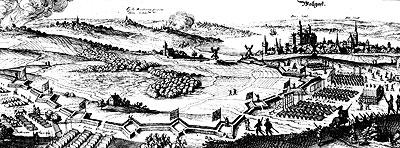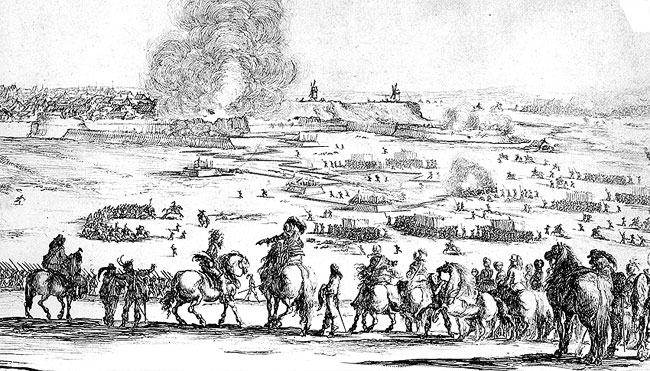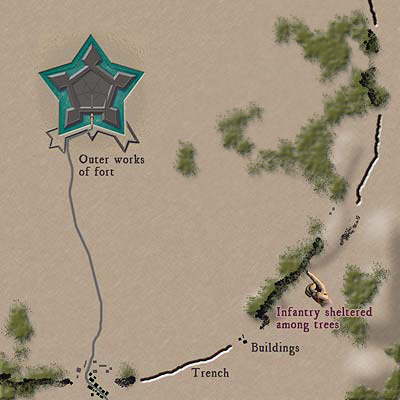 |
All Around the Fort |

This image illustrates well the distance from the besiegers' outside perimeter to the fort (shown at far left spewing smoke).
After the primary routes to and from the fort were taken, besiegers strengthened their hold around the fort. They did not "tighten the noose," but rather filled in gaps and "thickened the rope of the noose" to ensure the defenders were held in and everyone else kept out.
For this more troops came in. A perimeter was established along the already seized points, using any defensible position to be had, from a house to a knoll to a barn to some entrenching to a few trees. As with investing the fort, haste was recommended for setting up the perimeter; sometimes this step was begun before the main body of the army marched in. Besiegers established the perimeter primarily to have defensive positions should the enemy send in a force to relieve their just-entrapped garrison. And with an established perimeter, besiegers finished choking off supplies to the besieged.
 |
Another image illustrating distance from besiegers to besieged. Note the zigzag trench (Doubleclick this link to return) - The Siege of Arras, 1640, by Stefano Della Bella
|

This detail from a woodcut depicting a 1524 siege shows a trench wide and deep enough to contain tents. (It also shows a skirmish winding down.)
The perimeter, not surprising, had to be outside the effective range of the defenders' artillery. Mind that a 24-pounder cannon can hurl a solid cannonball over 1,800 meters. Therefore, establishing an impermeable circumference required a lot of soldiers because they had to cover much more territory than their ancestors laying siege in the Middle Ages to a castle.
During the early decades of the 1500's, besiegers were content to make use of already present features to make the perimeter, with trenching only where deemed necessary. But a trench offered such good protection from enemy probes - and the stray long shot. As a bonus, besiegers could move within their trench to one part of the perimeter to another without being seen. The practice of encirclement evolved to favor trenching over use of protective places that stuck up. Trenching was often enhanced with small fortifications. Besides, with soldiers settling down to wait, what better use to put them to than to dig their own shelter.

In the first decades of the 16th century, the outside perimeter for attackers could have been as above, with some trenching and other parts of the line forming along natural cover or among buildings (but above ground). Black indicates where attacking soldiers are. Only a quarter of the perimeter is shown.
From 1579 (until well into the 18th century), the perimeter was completely dug out to form a continuous trench, the circumvallation, in case enemy forces (or an entire field army) sought to relieve the beleagered fort. Click to see the circumvallation (in blue).
Should any serious action be anticipated from those inside the fortifications, a second trench (or set of trenches) was dug inside the circumvallation. This second trenching was the countervallation. Click to see that (in black). Often the camp of the besiegers was between the two lines
Double click either link to return to the early version of the perimeter.
The engineering of the perimeter trenching evolved to become what was termed "circumvallation," a continuous trench with fortified positions that encircled the fort. The direction of this evolution was seen at Milan in 1522 and Pavia in 1524, carrying over a medieval siege technique. Duke of Alva's engineer, Chaippino Vitelli, improved on the techniques of Milan and Pavia by integrating a system of earthen strongpoints and interconnected ditches for the siege of Mons in 1572. The first complete circumvallation was for the Duke of Parma's siege of Maastricht in 1579. With that, circumvallation became the standard for sieges to ward off anyone from outside attempting to relieve the besieged.
Should the besiegers anticipate a strong sally or even a counterattack from inside, a parallel (roughly) circumference of trenching was dug inside the circumvallation. This second trench was referred to as the "countervallation."* The pair of completed trenches was considered unassailable to any relief force until well into the 17th century.
The 1572 Siege of Mons served as an example of why besiegers needed to construct defenses of their own. The Spanish surrounding Mons were subject to artillery fire from the fort and were also pressed by a Dutch relief army on the other side of their lines. The relieving Dutch army itself was struck by another Spanish force from the outside. Like a shooting-range target, a ring of Spanish surrounded the ring of Dutch who surrounded Spanish who surrounded Dutch-held Mons, which was the bulls-eye. Vitelli's engineering enabled the Spanish to hold off the Dutch to force Mons to capitulate.
What was the circumference of a circumvallation? Okay, a little math: assuming a distance of around 1,800 meters from the fort to the digging, the resulting circumvallation would be a minimum of 11,310 meters. But the digging was not in a perfect circle; obstacles were worked around. In addition, fortifications such as redoubts had to be constructed, too, along that line. In 1602 at the siege of Grave, Maurits van Nassau had ordered each redoubt to have its own wet ditch and drawbridge, and to ride the line and inspect the work required five hours of his time. In 1637, Spanish sieges lines around the little fortress of Leucate went on for 2,400 meters, requiring 4,000 sappers and 13,000 regular soldiers, but Metz in 1552 required 12,200 meters and more than three soldiers for every meter. Adding a ring of countervallation to that of the circumvallation naturally doubled the amount of excavation; Dutch siegeworks around the major town of 'sHertogenbosch in 1629 added up to 40 kilometers (but required only 25,000 men). John Muller, The Attac and Defense of Fortified Places, 1759, recommends 10,800 feet from the fort's center to the perimeter to make a circumference of 21,200 meters, but this is the post-Vauban era in which armies were somewhat larger in size, thereby affording a wide perimeter.
Should the trenches or the camp be within range of even one cannon, there could be consequences: "As we skirmished outside this fortress many stayed where they sat (a euphemism of the time for killed), both men and women. There was a cannon in there which we called the skirtchaser, and one day early in the morning they shot all four legs off a man and his wife... in the hut next to my tent." account given by Peter Hagendorf, a soldier during the Thirty Years War
| Back |
Digging to the Fort |
|
|
|
*John Muller plus others have referred to countervallation as "contravallation."
All trademarks and registered trademarks appearing on this site are the property of their respective owners.